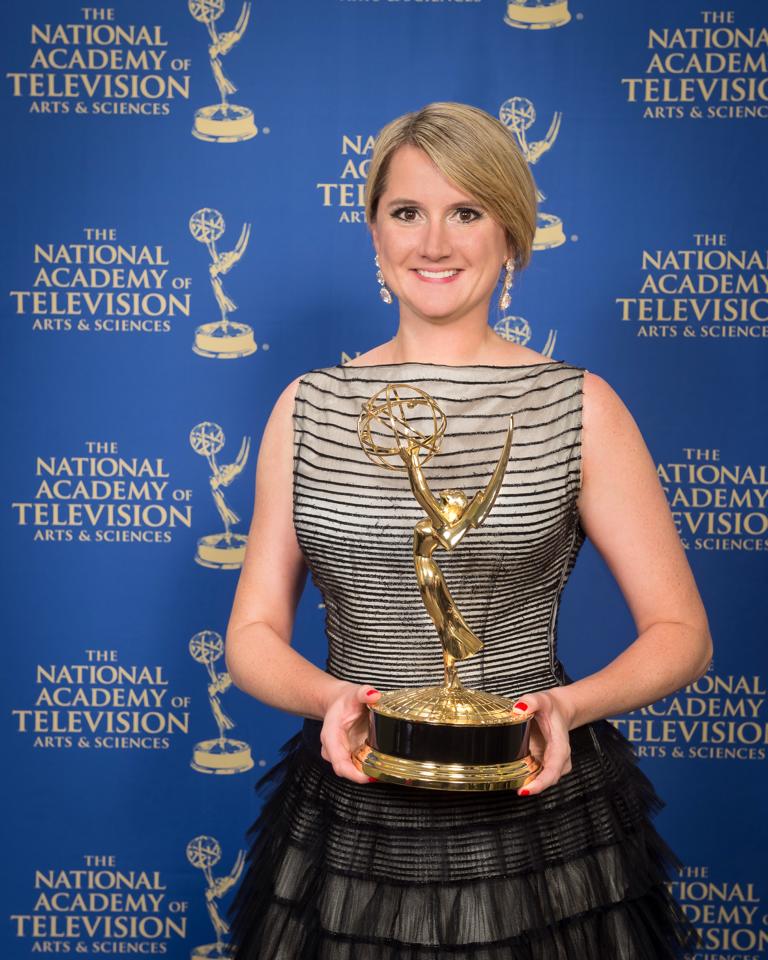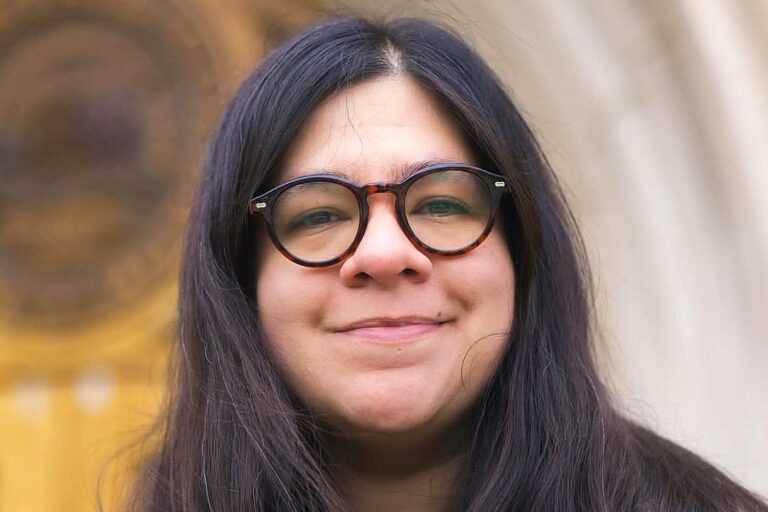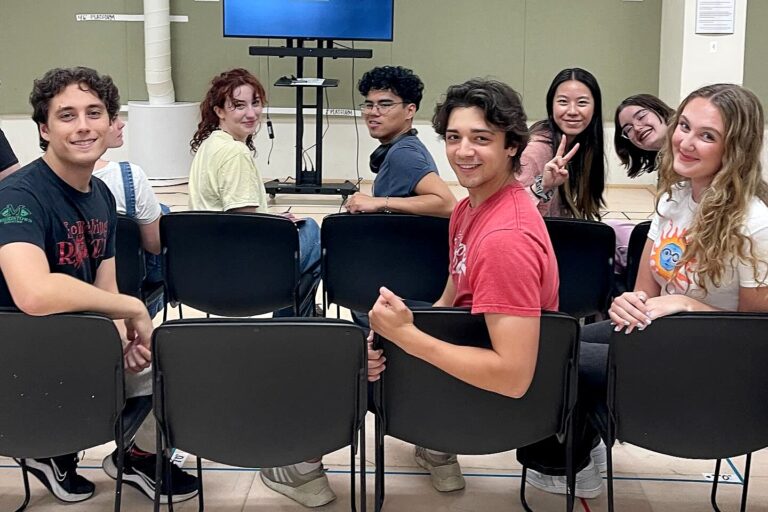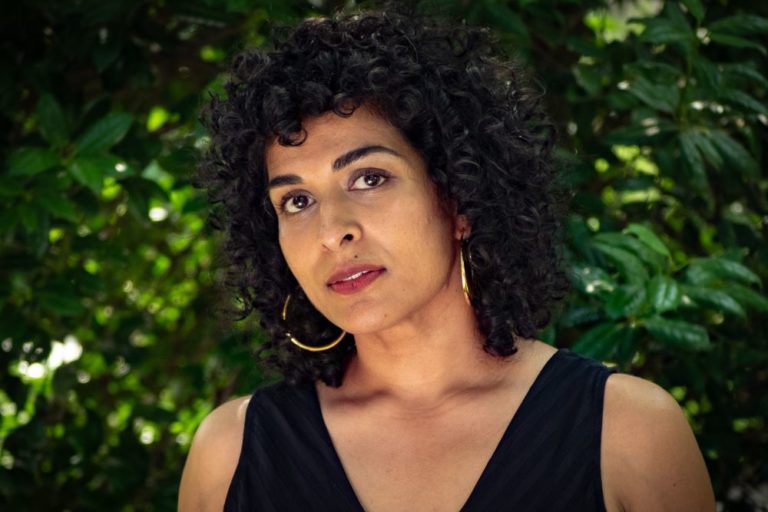A degree in Art History doesn’t usually lead to an Emmy Award, but for alumna Amy Williams, her MSU education helped catalyze an acclaimed career in production design. Over the past decade, Williams has worked as a production designer on an array of films, TV shows, commercials, and music videos, using her background in art history as a creative foundation for her work.
Among Williams’ catalogue is an Emmy award she won in 2014 for her production design on A Crime to Remember, a true crime recreation docuseries, which was one of the first TV series she worked on.
“I think I screamed out when I won,” Williams said. “I was very nervous and didn’t expect it at all. I was hesitant working on the show because it was a true crime recreation show, but the producers wanted to make true crime look cinematic, so to have that immediately rewarded was incredible.”

Had Williams been able to peek into her future as a college student, she said she would have been shocked — and not just because of the Emmy. After graduating from MSU with dual degrees in Political Science and Art History, Williams worked for the Detroit Institute of Arts and The Kreeger Museum in Washington, D.C., where she collaborated with artists to curate their exhibits.
She eventually moved to New York and continued to work in the private art sector. Although she enjoyed working with artists, she missed creating her own work, which is a passion she has carried since childhood. Ultimately, she decided to change career tracks, although production design wasn’t initially on her radar.
While I was at MSU, I took a few film classes and I was always interested in that field, but I didn’t know what a production designer was or that it would be the perfect career that melded all of my interests.
“While I was at MSU, I took a few film classes and I was always interested in that field, but I didn’t know what a production designer was or that it would be the perfect career that melded all of my interests,” Williams said. “It took me a few years, but I think having all of these varied experiences only makes me more well-versed in how the world looks and operates.”
After completing internships for production companies, location scouting, and networking within the film industry, it became clear that production design was the perfect direction for her career. The field allowed Williams to combine her interests in history, architecture, philosophy, and interior design to conceptualize vibrant sets that make cinema come alive.
Since her first internship in 2005, Williams has been a production designer on several films including Sleeping with Other People, Love is Strange, and Jamie Marks is Dead, and TV shows such as Little America, Crashing, and Master of None.

“I definitely think my Art History degree helps in my career. You learn a lot about color theory, symmetry, composition, and different styles and periods,” Williams said. “I use a lot of artwork and photography as inspiration for the looks of my projects.”
Each project Williams works on is unique, but the process of conceptualization always begins with reading the script. She reads scripts with special attention to characters, taking note of their personalities, hobbies, and style in order to realistically capture their environment. She also collaborates with the director to share ideas and inspiration, taking into consideration the type of film the production will be captured on, the location of the shoot, and the overall theme of the script.
I definitely think my Art History degree helps in my career. You learn a lot about color theory, symmetry, composition, and different styles and periods. I use a lot of artwork and photography as inspiration for the looks of my projects.
Once production ramps up, Williams’ role as production designer becomes all-encompassing, requiring her to manage a wide array of people on set, including costume designers, painters, prop masters, set dressers, and the art director.
“I don’t think people realize that production designers actually have the largest number of people to manage in a film,” Williams said. “I’m usually managing a massive team of people, and keeping them engaged and motivated with my ideas is the hardest part of the job.”
Williams was a production designer on all three seasons of Master of None, a critically acclaimed Netflix comedy series created by Aziz Ansari and Alan Yang. The series loosely follows Ansari’s real-life experiences as a New York-based actor, which is dramatized by the character Dev, also played by Ansari.

At first, Williams was apprehensive about doing production design for a comedy series since the genre typically isn’t aesthetically pleasing or cinematic. However, Ansari and Yang made it clear that they wanted Master of None to break away from the cinematic conventions of comedy, and Williams was the perfect candidate to make that happen.
“One of the best compliments I’ve gotten in my career was someone saying that Master of None really nails the American immigrant décor,” Williams said. “A lot of times [creating designs] starts from photography and exploring street photographers from different countries. I’m always trying to get into people’s personal spaces, and photography a lot of times does that. I always start by asking, ‘What’s on your nightstand? What are the books you’re reading?’ And whenever possible, I think speaking to someone from a particular culture or country and finding out what their experiences are is great.”
Of Master of None’s three seasons, the latest installment was most memorable for Williams, who also was a producer for that season thanks to her extensive work on set.
One of the best compliments I’ve gotten in my career was someone saying that “Master of None” really nails the American immigrant décor.
The third season was primarily shot in one location: a cottage-style home built from scratch in London. And since the show was shot in one environment, the pressure was on Williams to create a space that kept audience members engaged and captured intimate details of the two lead characters’ home life. Season three also presented challenges for the crew, as it was shut down in March 2020 due to COVID-19. When production started again, the crew was more limited, leaving Williams with more responsibility.
The third season of Master of None also was special to Williams because it veered away from Dev’s storyline and instead captured the relationship between two female characters, Denise and Alicia. Williams had greater input on the script itself as a woman working on set, which was unusual to her as a woman working in film.

“A lot of times I’m still the only woman on the team,” Williams said. “It’s a very male-dominated field, but in the last few years it’s been exciting because that’s not necessarily the case anymore. For example, from season one in Master of None, I always wondered about Denise’s character and what her apartment might look like. I didn’t get to do that in the first two seasons, so it was great to see how [Ansari and Yang] evolved as straight males in the industry telling a story about queer females.”
Williams deliberately chooses to work on projects that amplify marginalized stories like those depicted in Master of None. She also has worked on Little America, a series that depicts the lives of immigrants in the United States.
A lot of times I’m still the only woman on the team. It’s very male-dominated field, but in the last few years it’s been exciting because that’s not necessarily the case anymore.
“I tend to work on a lot of queer stories and stories about people of color because those are the stories we haven’t explored and are more interesting because they haven’t been heard,” Williams said. “For Little America, I got to explore all these different cultures and backgrounds, so that was also really interesting.”
Williams has come a long way from her time working in museums to becoming a production designer on critically acclaimed films. Throughout her journey, though, there is one piece of advice that has stuck with her.
“A great bit of advice I got early on in my career was from a curator at the Detroit Institute of Arts, and he said, ‘Don’t be the pretty girl at the front desk who assists people, don’t be the one that is good at typing or any type of assisting skills, because you’ll stay in that position and you’ll be seen as that person. So, don’t do a good job at that.’ When you’re young and you’re coming out of school, you’re hungry and you’ll take whatever you can get, but remember to stay ambitious.”
And, staying ambitious might even earn you an Emmy award one day.
Written by Annie Dubois
Photos provided by Amy Williams


